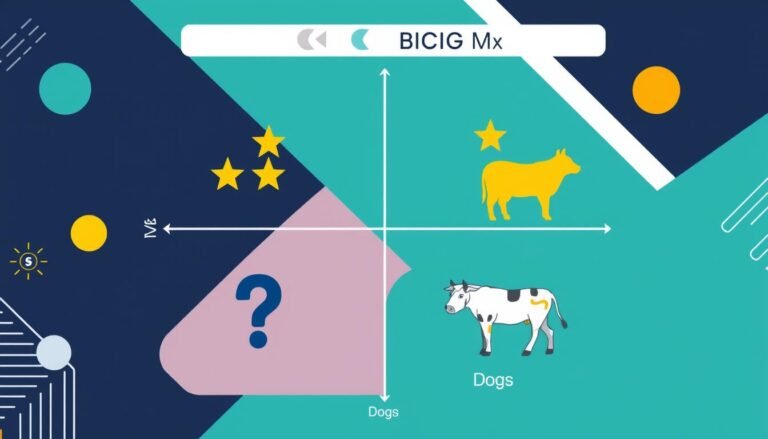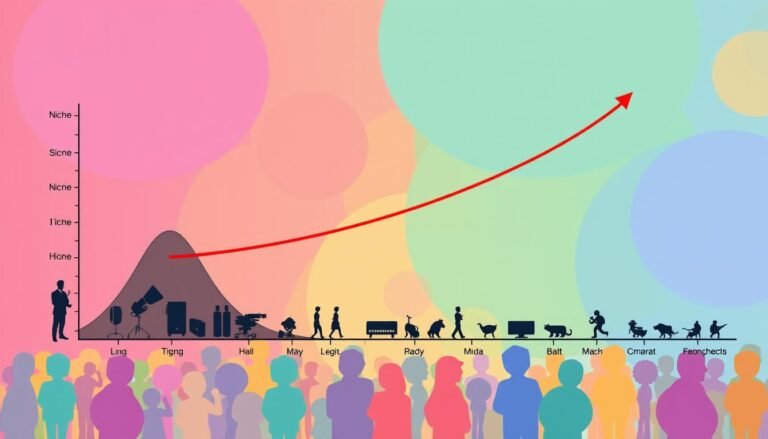Business Model Canvas: Blueprint for Success
Have you ever wondered why some startups do well while others don’t, even with the same resources? The key often is their business model. The Business Model Canvas is a detailed tool that helps entrepreneurs plan their business. It lets them see and improve their path to success.
By mapping out how they make, deliver, and get value, founders can plan better. This approach helps them meet their goals and manage money well.
The Business Model Canvas (BMC) helps entrepreneurs define nine key parts of their business. This tool brings clarity and focus. It also helps spot weaknesses that could slow growth.
A strong BMC improves team communication and impresses investors. It shows a deep market understanding and a clear plan for making money.
Key Takeaways
- The Business Model Canvas is key for a startup’s core strategy.
- It has nine main parts that make understanding and teamwork better.
- A detailed Canvas finds areas to improve and grow.
- It’s important for winning over investors and sharing a clear market plan.
- Using BMC is a top strategy for leaders like GE, P&G, and Nestlé.
Understanding the Business Model Canvas Framework
The Business Model Canvas is a powerful tool for strategy. It turns complex business ideas into a simple, one-page document. This makes it easier for entrepreneurs to check and improve their plans. It helps teams and stakeholders understand the business better, improving communication and strategy.
The Importance of Visualizing Business Models
Knowing your business model well is key to good market analysis. The Business Model Canvas helps create a clear view of the business for everyone involved. This leads to more creativity and new ideas. It’s flexible, so it can change as the business grows and the market changes. This makes it a must-have for both new and established companies.
Nine Key Components of the Canvas
The Business Model Canvas has nine main parts that make up a successful business plan. These parts are:
| Component | Description |
|---|---|
| Customer Segments | Groups of people or organizations targeted by the business. |
| Value Proposition | The unique value offered to customers that differentiates the business. |
| Channels | Ways in which the business delivers its value proposition to customers. |
| Customer Relationships | The types of interactions a business establishes with its customer segments. |
| Revenue Streams | The financial gains generated from delivering the value proposition. |
| Key Resources | The necessary assets to deliver the value proposition effectively. |
| Key Activities | The crucial actions undertaken to fulfill the value proposition. |
| Key Partners | External companies or resources necessary for achieving key activities. |
| Cost Structure | The various costs involved in operating the business model. |
Customer Segments: Defining Your Target Audience
Understanding different customer segments is key for a business to succeed. Entrepreneurs must break down potential customers into groups by their needs, likes, and actions. This helps tailor products to meet their specific wants.
Identifying Different Customer Groups
Customer segments can be grouped by their needs, how they buy products, and how much profit they bring in. Factors that affect this include:
- Demographics: Age, income, gender, education, and occupation.
- Geographics: Location, climate, and cultural differences.
- Psychographics: Lifestyle, values, attitudes, and personality traits.
- Behavioral segmentation: Looking at how they buy and stick to brands.
Businesses might aim for a wide audience with similar needs or focus on specific groups with unique offers. Knowing these groups helps tailor products to their unique characteristics.
Segmentation Strategies for Market Analysis
Creating good segmentation strategies is crucial. Key parts include:
- Setting clear goals for segmentation.
- Gathering data for customer insights.
- Choosing the right criteria for segmentation.
- Segmenting data and making clear customer personas.
- Creating strategies that meet each segment’s needs.
Businesses should check their customer segments against their goals. Using key metrics helps see if strategies work. Making changes based on customer feedback keeps offerings in line with what customers want.
| Segmentation Type | Characteristics | Examples |
|---|---|---|
| Demographic | Age, gender, income level | Millennials, high-income families |
| Geographic | Location, climate | Urban vs. rural, coastal vs. inland |
| Psychographic | Lifestyle, values | Health-conscious, eco-friendly consumers |
| Behavioral | Purchasing habits, loyalty | Frequent buyers, brand loyalists |
By focusing on what customers want, businesses can use their resources better. They can make products that really speak to their target audience.
Business Model Canvas: Crafting Your Unique Value Proposition
Creating a strong value proposition is key to standing out in a crowded market. It means showing what makes your business special to meet customer needs. By knowing what makes you different, you can share the real benefits of what you offer, building stronger bonds with customers.
Differentiating Your Offerings
Many top companies stand out by offering something new, better quality, or amazing service. TOMS Shoes, for example, gives back to social causes with every purchase. Dollar Shave Club became popular by offering quality razors at a good price.
Aligning Products and Services with Customer Needs
Meeting customer needs can give your business a big boost. For example, focusing on specific customer groups can increase customer loyalty by 30%. By understanding your audience through research and social media, you can tailor your approach. Netflix, for instance, offers endless streaming to meet the growing need for easy access to entertainment. Knowing what customers want helps build trust; 76% of people prefer brands with a clear value proposition.
Revenue Streams and Cost Structure: Balancing Profits
Knowing how a business makes money is key to its success. Revenue streams and cost structure are crucial for making profits and staying strong. By looking at different ways to make money and keeping costs low, companies can stay financially healthy. This helps them grow for the long term.
Understanding Different Types of Revenue Models
Businesses can use many ways to make more money. Here are some common ones:
- Transaction-based revenue streams: This includes selling things online, in stores, tickets, apps, and services like consulting or legal advice.
- Project revenue streams: One-time money can come from building things, making websites, planning events, and marketing.
- Recurring revenue streams: Things like software subscriptions, membership fees, renting out property, and maintenance contracts bring in steady money over time.
Each kind of revenue stream helps shape a company’s strategy. It lowers risk and helps adapt to market changes.
Managing Costs for Sustainable Growth
Knowing what a company spends money on is vital for staying profitable. It’s important to split costs into fixed and variable ones. This lets companies see where they can cut back. Keeping costs in check helps maintain good profit margins and supports growth.
By always checking their costs, companies can find ways to save money. They can use their resources better and match their spending with their income. This makes them stronger against market ups and downs and helps their business thrive.
Conclusion
The Business Model Canvas is a powerful tool for entrepreneurs. It helps them build strong business models by looking at nine key areas. These include customer segments and value propositions to cost structure.
This tool is crucial in fast-changing industries like publishing. It helps businesses stay flexible and adapt easily.
Using the Business Model Canvas also helps improve customer relationships and revenue streams. It shows the best ways to share products or services. This can be through social media, email, or ads.
For the best results, entrepreneurs should keep updating their strategies with the canvas. This keeps up with new trends and strengthens the model’s parts. By doing this, businesses can innovate and stay ahead in a changing market.
Source Links
- Business Model Canvas: Your Startup’s Blueprint to Success
- Business Model Canvas (BMC): The Ultimate Guide – SM Insight
- The 9-Step Business Model Canvas Explained (2023 Update)
- How To: Business Model Canvas Explained
- Business Model Canvas: Explained with Examples | Creately
- Business Model Canvas Explained
- Customer Segments – Business Model Canvas
- What are the Customer Segments of Business Model Canvas?
- Using Customer Segments to Market Your Business
- Business Model Canvas: Crafting Value Propositions In-Depth – Blog
- Crafting a Unique Value Proposition in Your Business Model Canvas – FasterCapital
- How to Create and Use a Business Model Canvas
- Master Your Business with the Business Model Canvas | Magnet
- Revenue Streams in Business Model Canvas
- Business Model Canvas — NEXEA
- Business Model Canvas To Test Your Business Model







